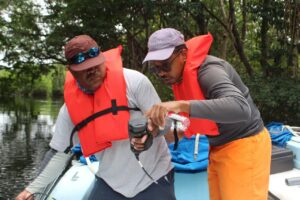The Climate-influenced Nutrient Flows and Threats to the Biodiversity of the Belize Barrier Reef Reserve System (BZ-SDG) project, supported by NASA’s Biological Diversity and Ecological Forecasting Program, focuses on studying the impacts of current and future riverine discharge on the health of the Belize Barrier Reef Reserve System (BBRRS). While the BBRRS is a UNESCO-designated World Heritage Site that is a cornerstone of Belize’s Blue Economy, threats from land use change and climate change could significantly impact the health and biodiversity of this significant assemblage of ecosystems. The project has recently completed a third year of joint fieldwork between US- and Belize-based researchers at Wildlife Conservation Society (WCS) in Belize City. In-situ water sample collection for sediments and key nutrients in the barrier reef lagoon is being used to calibrate and validate a remote sensing-based model of water quality. This represents just one use of satellite remote sensing, which will also form a key part of the Belize’s revised Integrated Coastal Zone Management Plan, the country’s guiding document for managing coastal development. Over the past 3 years, the team has conducted multiple in-person and virtual stakeholder workshops with partners in Belize and has published early results in Frontiers in Marine Science, Marine Pollution Bulletin, and Remote Sensing of Environment.

